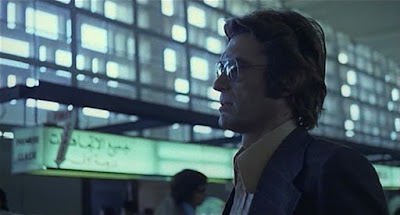The crazier these krimis got the better they were and this one is crazier than most. It opens with a mad scientist who has just invented a new lethal gas. He sells it to a criminal gang, but the payoff he receives is not what he expected.
Soon afterwards a series of murders takes place at an exclusive girls’ school in England. The murders appear to be the work of a madman, but the audience knows that they are carried out by a man who is in prison. With the help of corrupt prison guards he is able to leave his cell each night to carry out the murders.
The killer is employed by a mysterious man whom he never sees, a man who has a fondness for aquatic animals like sea turtles and crocodiles. He’s a classic diabolical criminal mastermind, but just what is it he is trying to achieve?
This is a tough case for Inspector Higgins (played of course by Joachim Fuchsberger), and it’s made even more difficult because his boss at Scotland Yard, Sir John, has just completed a course in criminal psychology and insists on interfering in the case with his hare-brained psychological theories.
There is a mysterious red-robed figure who is described in the English dubbed version as a monk although he looks more like a Ku Klux Klansman in red. There are also lethal Bibles and guns that fire deadly gunk at unsuspecting victims. The body count is extremely high in this movie, but that’s fairly typical of this genre - you never get just one murder in a krimi, and in this one a large proportion of the cast gets bumped off in various bizarre ways.
There’s a plethora of suspects for Inspector Higgins to deal with, including a writer who takes an excessive interest in the girls at the school and a chemistry teacher who takes an even more excessive and unhealthy interest in the girls. Either could be the criminal mastermind, but then so could the gardener or the headmistress. Or just about anyone else. Everyone seems to have something to hide.
Joachim Fuchsberger is as reliable as ever and the supporting cast is excellent. Strangely enough Eddi Arendt is not on hand this time to provide comic relief, so these comic duties are assumed by Siegfried Schürenberg as Sir John, with his half-baked psychological theories. Luckily he is actually quite amusing.
This particular movie was, unlike the earlier entries in this cycle, made in colour. This is actually the first krimi I’ve seen in colour.
There are some nice visual touches (as you expect in a movie directed by Alfred Vohrer) and some fairly cool sets which include a cage suspended above hungry crocodile and a swimming pool with underwater windows which allow for some clever underwater scenes.
There’s plenty of fun to be had in this movie and if you’re a fan of the Edgar Wallace krimis you’ll want to see this one. If you haven’t yet discovered the joys of this genre then it’s about time you did although, as good as this movie, you’re probably better off starting with the earliest of them, such as the wonderful Fellowship of the Frog (Der Frosch mit der Maske).
Dark Sky’s DVD release boasts a lousy pan-and-scanned English-dubbed transfer of which they should be ashamed. Sadly this is a genre that is rarely available in decent transfers with English subtitles although there are a few German releases that are excellent and that do include English subtitles.
The movie can be thoroughly recommended. This DVD release cannot, but unfortunately it’s the only chance you’ll get to see this movie in an English-friendly version.




























